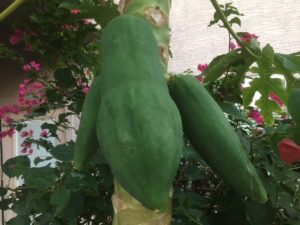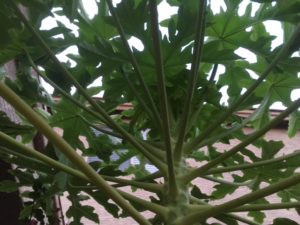Growing Papaya in Hot, Dry Climates

Papaya can be a bit of an acquired taste. Some people are put off by the smell of papaya, but I really enjoy papaya with a little fresh squeezed lime. Papaya is also packed with nutrients. I always thought of Papaya trees as something growing in the Hawaiian islands, not in the Arizona desert. I discovered that it isn’t really that tough to grow papaya in hot, dry climates like the desert.
Papaya trees are generally grown from seed. It is relatively easy to germinate seeds, even from a store bought papaya. Papaya has tons of seeds in one fruit which could be enough for a papaya forest.
Just scoop out a bunch of seeds and clean off the gelatinous coating, than you can just directly sow them into soil if it is warm enough.
It’s also easy to start them indoors if you need too. You want to make sure is that you are either growing a variety that is self-pollinating or you are prepared to grow a few papaya trees to ensure you can get cross pollination with a male and female tree.
Papaya fall under two main types Hawaiian and Mexican. Mexican Papayas tend to be better suited for hot, dry climates and have a red flesh. Mexican Papayas tend to be larger sized fruit.
Tainung Papaya
I selected a variety called Tainung Papaya, which has been successful in my area. Tainung Papaya is a red fleshed Mexican variety.
Tainung is also a dwarf variety, so it doesn’t get as large as some varieties. I purchased it as a small starter plant about 6inches tall.
It grew rapidly during the summer and started flowering about 7 months after planting. Papaya is a rapid growing tree, but is short lived. It’s actually not really a tree, but a shrub or herbaceous succulent.
Papaya can produce in about a year which is pretty quick for a fruit tree.
Fruit
Papaya fruits can range in size from 12 ounces to 20lbs. You can typically tell when a papaya is ripe when it changes from green to yellow or orange on the outside.
Tainung papaya does keep some of its green color, so if you press the fruit and it is somewhat soft to the touch, it’s good to pick.

Gardening Skill Level
I would rate growing a papaya tree as a moderate skill level for gardeners in hot, dry climates. It is sensitive to frost, which takes some extra consideration with care.
Papaya can be finicky with its watering regimens. If you can figure out how to water properly and frost protect it, then you will be well on your way to homegrown papaya.
Suitable for Container Growing
Papaya trees are suitable for container growing, but I’d recommend planting in the ground when possible. I am growing my Tainung Papaya in a 15 gallon container, which is pretty cramped.
I didn’t want to try to transplant the tree into a larger container, since they can struggle with transplanting. They really don’t like to have their roots disturbed.
So, it’s probably best to plant in a 25 gallon size or half barrel. I wasn’t sure if it would fruit in a container, but I currently have 5 papaya on the tree.
Tainung is a dwarf variety, so if you are going to try to grow a Papaya in a container look for dwarf types. Papaya trees don’t have huge root systems, so they can be contained in a container.
The main reason I decided to container grow my papaya was that I was concerned about losing my Papaya to cold snaps.
I had thought they were more sensitive to cold, due to some of the things I read when doing research. I figured that in a container I could move it to an indoor location if needed.
The Papaya tree became too large for me to move around after the first summer, so I never even brought it indoors in the winter.
I hung a shop light on a branch, which seemed to work fine and the tree is close to the house which keeps it warmer.
A plus for growing papaya in containers is that you can ensure the tree has good draining soil to prevent root rot. Papaya trees are really susceptible to root rot, especially in the cold months.
Planting Tips
If planting in the ground, drainage is a must. I would recommend planting on a mound, so water doesn’t pool up around the trunk.
I would consider amending the soil take a look at my post “How to improve clay soil for fruit trees.”It’s also good to top it with a generous amount of compost and mulch.

Watering
I water my Papaya frequently in the hot months. The leaves are large and transpire, so they tend to get droopy when thirsty.
It’s important to keep Papaya fairly dry in the cooler months. They are really prone to rot if sitting in wet soil in the winter. I hardly water my Papaya tree in the winter.
If it was in the ground in our clay soil, I probably wouldn’t water in the winter months.
Feeding
Papaya are a little bit heavier feeders. I tend to give mine more frequent doses of compost and heavier nitrogen based fish fertilizer. I also feed with liquid seaweed and foliar spray.
Sun Exposure
Papaya like a lot of sun exposure and I’ve heard of the Mexican varieties taking full sun even in our extreme desert climate.
My papaya tree is in a location that gets sun until around 2 and has done great. Occasionally, I may see some sunburn on the leaves.
Potential Problems
Root rot is a concern, but mainly during the cooler temps. I also try to avoid watering near the trunk of the tree.
Papaya trees tend to cycle through leaves fairly quickly since they do grow pretty rapidly. So, don’t be alarmed if some of the older leaves are yellowing, drying up, and falling off.
If the entire leaf system is yellowed, than that is cause for concern. It could indicate a watering issue or that the plant is in need of food.
Other than cold and root rot, I haven’t experienced many other problems with papaya. Pests haven’t seemed to bother my Papaya tree much.
RELATED POST: 7 Reasons Why Your Fruit Trees are Losing Leaves
Please comment below on anything you enjoyed about this post or any of your experiences growing papaya in hot, dry climates.


I have been trying to get some Royal Star seeds for years, can I purchase some from you? Thanks, -Pat
where are you located?
Hi, do you get snails and slugs where you live? They climb in to papaya trees (!) and eat flowers and fruit. No point baiting around the bottom, (rain would spoil bait!) as they are already up the top. is there such a thing as a trap to kill them? They start eating them when they are still green, so I can’t pick them. Trying to think of some way to put the bait up where they are in weatherproof traps! Just a thought. Good luck with your garden, looks amazing! Cheers from New Zealand
I recently purchased two papaya that are supposed to be dry forest and more cold hardy than Mexican papaya. http://sacredsucculents.com/ From the site, “Carica pubescens. Seed collected from Ollantaytambo, Cusco Dept., Peru, 9300′. Highly drought tolerant, though dislikes prolonged excessive heat. One of the parent of the ‘Babaco’ hybrid cultivars grown throughout South America. Fruits surprisingly well here in northern California in areas of mild frost. Z9a/b.”
And “Carica quercifolia. Large drought deciduous leaves. Fragrant yellow-green flowers, unisexual. Deep orange papaya fruit to 2–4″, highly edible and borne in mass. An Andean dry forest native, we’ve observed this stunning species in habitat between (6000–9000’+) in central Bolivia and northern Argentina. Tolerant of some frost but only when kept relatively dry. Z9b.”
Both are planted in 20 gallon tubs on the south side of the house where quercifolia gets shade after 2 PM. The pubescens gets shade most of the day. Tempted to, but not keeping my fingers crossed 🙂